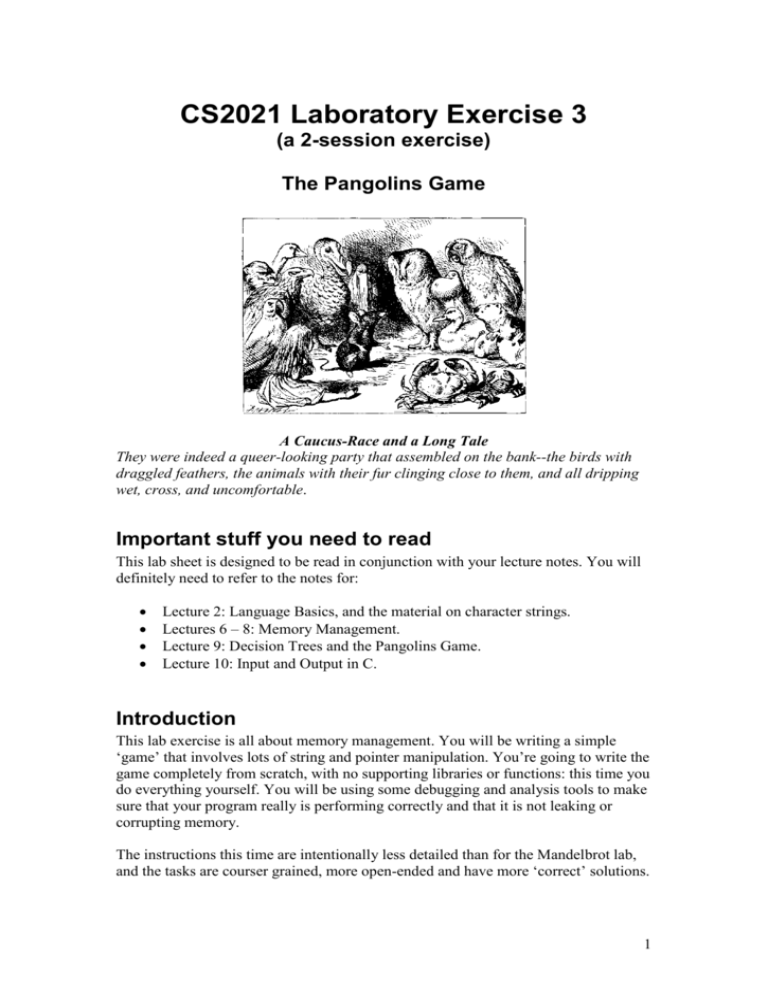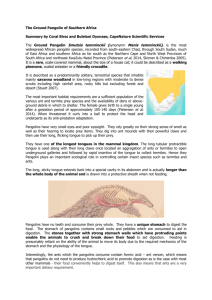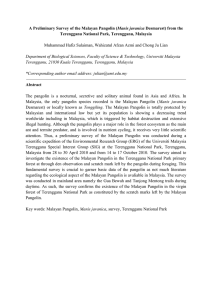pangolins lab 2
advertisement

CS2021 Laboratory Exercise 3 (a 2-session exercise) The Pangolins Game A Caucus-Race and a Long Tale They were indeed a queer-looking party that assembled on the bank--the birds with draggled feathers, the animals with their fur clinging close to them, and all dripping wet, cross, and uncomfortable. Important stuff you need to read This lab sheet is designed to be read in conjunction with your lecture notes. You will definitely need to refer to the notes for: Lecture 2: Language Basics, and the material on character strings. Lectures 6 – 8: Memory Management. Lecture 9: Decision Trees and the Pangolins Game. Lecture 10: Input and Output in C. Introduction This lab exercise is all about memory management. You will be writing a simple ‘game’ that involves lots of string and pointer manipulation. You’re going to write the game completely from scratch, with no supporting libraries or functions: this time you do everything yourself. You will be using some debugging and analysis tools to make sure that your program really is performing correctly and that it is not leaking or corrupting memory. The instructions this time are intentionally less detailed than for the Mandelbrot lab, and the tasks are courser grained, more open-ended and have more ‘correct’ solutions. 1 Nevertheless, we have identified some specific tasks for you to complete. This series of tasks will give some structure to your programming exercise and give us a means of marking your work. You will have to reply more on interpretation and initiative than before (which is much more like writing C programs in the real world!) So… the tasks contain a general description of what you are to do, with some advice, hints and tips. They don’t contain a line-by-line breakdown of what you should type into your program, and often they describe an intended ‘general outcome’ rather than a tight formal specification. The Game Of Pangolins Pangolins is a two player game, played between you and your computer. Its origins are lost in the mists of computer history, but Steve remembers it from his happy days as a ZX Spectrum programmer. You can see a Java applet that recreates the original game here: http://www.wearmouth.demon.co.uk/jav/pangolin.htm The idea is very simple. You think of something (an animal, a type of pudding, some form of fermented bean-based product, anything you like) and the computer tries to guess what you are thinking of by asking you a series of ‘yes/no’ questions. If the computer guesses correctly, it wins. If you manage to fool it, you win, but you must then provide the computer with a question that would allow it to guess correctly next time round. That’s all there is to it. Here’s an example game (your input it prefixed by ‘>’, and the computer’s output is in bold text) Think of something then. Is it a tin of baked beans? > No Is it a type of floor cleaning liquid? > No Is it an animal? > Yes Does it eat eucalyptus leaves? > No Is it a pangolin? > No Ok, you win, I have no idea. Tell me what you were thinking of. > a hamster Give me a question that will distinguish between a pangolin and a hamster. > does it like running in a wheel? And the answer for a hamster is? 2 > yes Great. Next time I’ll know how to tell the difference. Admittedly it’s not the most exciting of games. You won’t be snatched up by Electronic Arts for their next blockbuster, but, as you have surely noticed, it is all strings and trees based, and is an ideal opportunity to practise pointer and memory management in C. The Rules The game is straightforward. The computer starts knowing only about a single “object” (we’re using object in a non-technical sense here… an “object” is just a “thing:). Whatever object you’re thinking of, the computer will offer its first and only possible answer as its guess. If this guess turns out to be wrong, the computer will ask you for three things: 1. The name of the object you were actually thinking of 2. A question (with a yes/no answer) that distinguishes between the computer’s recent guess and your object 3. The answer to your question in the case of your object – yes or no. The computer accumulates this information in the form of a binary ‘yes/no’ tree (see your lecture notes for an example of this). Successive plays of the game cause the tree to grow as more questions and objects are added. The ‘knowledge base’ it accumulates is hopelessly clumsy: there is no attempt to balance the tree (so it could know lots about things that are animals and nothing about things that are not), and there is no attempt of any kind to give order to the questions or to maintain any real logical progression (for example, there’s nothing stopping the player from repeating questions higher up in the tree or causing nonsense or inconsistent answers.) But that’s okay; it’s just a C programming exercise not at attempt to create artificial intelligence. Task 1 : Basic structures You’ll first need to design the data structures. In C you are limited to ‘structs’ (rather than the true ‘objects’ which Java provides) but there’s nothing wrong (and quite a lot good) about thinking of these things in broadly object-orientated terms. So your first task is to design your data structures, and to write a ‘diagnostic’ function that will print out the contents of these for debugging purposes. However you decide to arrange the details of your data structures, they will form a tree, with objects and questions at the nodes and ‘yes/no’ decisions at the edges. Refer to your lecture notes again to see an example of such a tree. Task 1A: Define your data structure. You will probably use a struct to implement your data structure, but the more adventurous of you might like to try using a union (see Lecture 5). 3 Task 1B: write a function called pangolin_nodePrint() that will print out the status of a single node of the tree. Look at the example tree in Lecture 9 notes (the slide entitled “An Example Decision Tree”). If we called the function pangolin_nodePrint() on Node NNNN would give output similar to this: Object: [NOTHING] Question: does it like running in a wheel? Yes: a hamster No: a pangolin Alternatively, calling the same function on the pangolin node would give output similar to: Object: a pangolin Question: [NOTHING] Notice in this second example we have not printed out the ‘Yes’ and ‘No’ alternatives to the question since there isn’t a question. You may prefer an output that looks like Object: a pangolin Question: [NOTHING] Yes: [NO QUESTION] No: [NO QUESTION] It’s up to you which of these styles (or variants on these) you implement. Task 1C: Now, you should ‘hardcode’ a small tree of questions and answers into your program: you’ll need this both to test your pangolin_nodePrint() function and later to get the game off to a good start. We suggest you this play the game on a piece of paper, and build up a small tree (say 6 or 7 nodes) of questions and objects. Now create a data structure to represent this, and add it to your program. No need to use dynamically memory at this stage – you can just create the data structures using statically declared variables. If at this stage, you don’t know the difference between static and dynamic data, read your lecture notes again! You now have you very own Knowledge Base! Task 2 : Making it interactive Now you have the basic data structures in place, we’ll put the rest of the game in place. This is relatively straightforward, and involves simply using scanf() to get input from the user and build new parts of the tree in response to what the user says. When you hard-coded the data structures in Task 1C, they were conveniently allocated on the stack for you, strings and all. Since the compiler could tell from looking at your program how long your questions were, how many questions you had, how long the object names were, and so on, it could allocate appropriate amounts of stack for the job. However, when the game is being played ‘live’, there is no possible 4 way of predicting these sizes (“Who can predict what a user will type?”) so you will have to use dynamic allocation techniques to store the strings that are typed in by the user, as well as the structs that form the tree. The game should allow for arbitrarily long questions and object names, and in principle the tree can be extended indefinitely1 This means that it is simply not possible to use static arrays to store the tree or its contents; you’ll have to dynamically allocate memory using malloc(). One exception to this open-endedness, is that in order to read a string of characters from the user, it must be stored somewhere; there is no ‘standard’ function in C that will allow you to read in a string of unbounded length since you have to pass a buffer to the functions into which the string will be copied (so you have to know how long your maximum string/buffer size is in advance.) Unless you want to go to the effort of writing an extensible input-getting function, this means you have to choose a sensible length of buffer to statically allocate, use one of the standard ‘input’ functions from the C library (we’d recommend scanf()) making sure to tell the function what the maximum number of characters to accept is, and finally copy the string from your fixed size static buffer into a snug-fitting dynamically allocated buffer within your game tree. Its not a perfect solution, but it will do fine for us here. A neat way of packaging this slightly unsatisfactory state of affairs up would be to write a function that asks for a user input of a defined maximum size, and then returns a malloc()’d string of exactly fitting the string that the user actually entered. Once you have a function (or functions) to deal with user input like this, coding the logic of the game so that appropriate questions are asked, appropriate guesses made and the tree dynamically created is relatively straightforward. Again, consult your lecture notes if necessary. So… do it. Write the game of Pangolins (you know you want to.) To get full marks for this task, you should make your game robust to the types of input that a user might give. For example… if the user gives ‘pangolin’ rather than ‘a pangolin’ as a reply, does you program produce text that reads correctly the next time round? (i.e. does it assume that the user has given the correct article (‘an’, ‘a’, ‘the’ etc.) before the object name?) What happens if the user forgets to put a question mark at the end of their question? Can they type ‘y’ as well as ‘yes’? Could they even type ‘absolutely’ or ‘correct’? You won’t be able to mitigate against all possible types of nonsense input, but given that the user is not trying to test an artificial intelligence program but might make a few genuine mistakes, can your program cope gracefully with these? Task 3 : loading and saving the game [ This would be a good place to get to by the end of the first lab session. In fact some of the file manipulations you now need to do might not have been discussed in the 1 Pangolins Grand Masters can play for days or longer, and have been known to retire indefinitely with solar powered laptops to ramshackle huts on cloudy peaks in the Himalayas to consider the True Nature of The Null Pointer. 5 lectures yet. But don’t worry. If you want to press on immediately, have a look in Oualline, especially Chapter 14.] Of course, at the moment, every time you finish your program, it will forget about everything it has learned. Hardly what you’d want. You task now is to write functions to load and save the question tree to a file. You might find it useful to allocate a unique natural number identifier to every node in your tree; you can then use this to capture the tree structure in a simple file format. An example of such a format is given below (although you can of course devise any alternative format of your choosing): <node number> <object> <question> <yes node number> <no node number> You will probably use fprintf() and fscanf() to read and write to a file. A slight snag here is that these functions by default separate fields using whitespace. Given that you will have whitespace in your questions and maybe your object names too, you will have to think of some way of distinguishing between ‘fields’ and ‘gaps in words’. You might consider replacing spaces in your questions and objects with a different character prior to saving, and reverting these characters back to spaces when loading. Alternatively, if you look in detail at the definition of fscanf() and fprintf() you’ll notice that you can modify the behaviour of these to solve your problem in a different way. Use whichever technique you feel most comfortable with. Task 4: Tidy up your mess When your program exits, all the resources such as file handles and memory chunks that you have used get returned to the operating system. This is a good thing, because most programmers leave huge piles of messy pointers and lumps of partly eaten memory lying about when their program finishes. For this exercise, you are to be much tidier. When you program is ready to finish, make sure you have explicitly free()’d all the memory that has been malloc()’d by you. You might want to do this recursively. Use valgrind to convince yourself that there is nothing going awry and that all the tiniest bits of memory have been free()’d correctly (you will need to demonstrate valgrind giving your program a clean bill of health to get your marks for this task) Task 5: Grand Unified Pangolin Processing Engine Make your program take an arbitrary number of input files, and graft them together to make a huge tree. Swap your files with your friends and get a huge collection of pointless questions. To do this properly you need to scan for duplicate entries (you won’t be able to do this perfectly, but it should at least weed out obvious duplicates and graft the trees together in sensible ways.) Phew, time for a nice cup of tea and a sit down. 6







